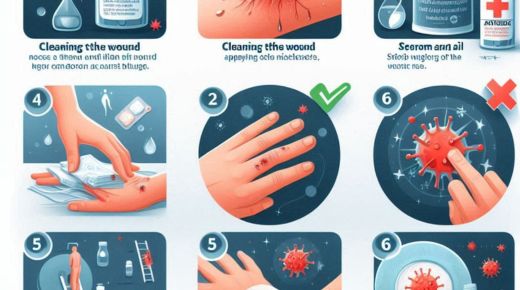Proper wound care is crucial to prevent infections and promote healing. When a wound becomes infected, it can lead to serious complications, prolong the healing process, and increase the risk of more severe health issues. Understanding how to prevent and treat infected wounds is essential for ensuring a smooth recovery. This article will provide you with the necessary tips and information to manage wound care effectively.
Understanding Wound Infections
A wound infection occurs when bacteria, fungi, or other pathogens enter the wound site, leading to inflammation and other symptoms. Common signs of an infected wound include:
- Increased Redness: Surrounding the wound
- Swelling: That extends beyond the wound edges
- Warmth: In the area around the wound
- Pain: That intensifies over time
- Pus or Discharge: Often with an unpleasant odor
- Fever: In some cases, the infection can cause a fever, indicating that the body is fighting off the infection.
If left untreated, an infected wound can lead to more severe conditions such as cellulitis, sepsis, or chronic wounds. Therefore, it’s crucial to take steps to prevent infection and know how to treat it if it occurs.
Tips for Preventing Wound Infections1. Clean the Wound Thoroughly
The first and most important step in preventing wound infections is to clean the wound as soon as possible. Use a wound wash solution or mild soap and water to gently cleanse the area, removing dirt, debris, and bacteria. Ensure that the wound is rinsed thoroughly to avoid leaving any contaminants behind.
2. Apply an Antiseptic
After cleaning the wound, applying an antiseptic solution or ointment can help kill any remaining bacteria and create a barrier against infection. Products like iodine, hydrogen peroxide, or antibiotic ointments are commonly used for this purpose.
3. Cover the Wound Properly
Covering the wound with a sterile dressing or bandage helps protect it from exposure to bacteria and other contaminants. Choose a dressing that suits the wound type—whether it’s a simple adhesive bandage for minor cuts or a more advanced dressing for larger wounds. Keeping the wound covered also maintains a moist environment that promotes faster healing.
4. Change Dressings Regularly
Changing wound dressings regularly is essential to prevent infections. For most wounds, changing the dressing once a day or whenever it becomes wet or dirty is recommended. During each dressing change, take the opportunity to inspect the wound for any signs of infection.
5. Keep the Wound Dry
While it’s important to keep the wound moist to promote healing, you should also ensure that it stays dry from external moisture sources, such as sweat or water. Avoid soaking the wound in water, and use waterproof dressings if necessary, especially when bathing.
6. Practice Good Hygiene
Always wash your hands before and after touching the wound or changing the dressing. This simple step can significantly reduce the risk of introducing bacteria to the wound site.
Treating Infected Wounds
If a wound shows signs of infection, prompt treatment is necessary to prevent the infection from worsening or spreading.
1. Consult a Healthcare Professional
If you suspect a wound infection, it’s important to seek medical advice. A healthcare professional can assess the severity of the infection and recommend appropriate treatment, which may include prescription antibiotics.
2. Keep the Wound Clean
Even after an infection develops, it’s important to continue cleaning the wound regularly. Use a wound wash solution or saline solution to gently cleanse the area. Avoid using harsh soaps or chemicals that could irritate the wound further.
3. Apply Antibiotic Ointments
In addition to oral antibiotics, your healthcare provider may recommend applying topical antibiotic ointments to the wound. These help combat the infection at the site and reduce bacterial growth.
4. Change Dressings More Frequently
When dealing with an infected wound, you may need to change the dressings more frequently to keep the wound clean and dry. This helps remove any pus or discharge and allows you to monitor the healing progress closely.
5. Monitor for Signs of Improvement
As you treat the wound, monitor it daily for signs of improvement. Reduced redness, swelling, and discharge are positive indicators that the infection is subsiding. If the wound does not improve or worsens, return to your healthcare provider for further evaluation.
When to Seek Emergency Care
In some cases, an infected wound can lead to serious complications that require immediate medical attention. Seek emergency care if you experience:
- Severe pain or swelling
- High fever or chills
- Red streaks radiating from the wound
- Difficulty moving the affected area
- Signs of sepsis, such as confusion, rapid heart rate, or difficulty breathing
Preventing and treating infected wounds is essential for a healthy recovery. By following proper wound care practices, you can significantly reduce the risk of infection and ensure that your wounds heal efficiently. Remember to clean the wound thoroughly, apply antiseptics, and cover it with an appropriate dressing. If an infection does occur, seek prompt medical treatment and follow the recommended care guidelines to prevent complications and promote healing. Proper wound management is key to maintaining overall health and well-being. Take care of your elderly relatives and search for absorbent sheets if they are needed.
